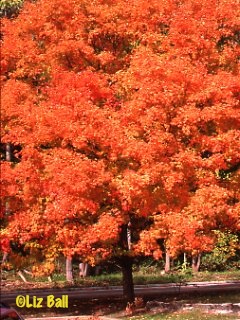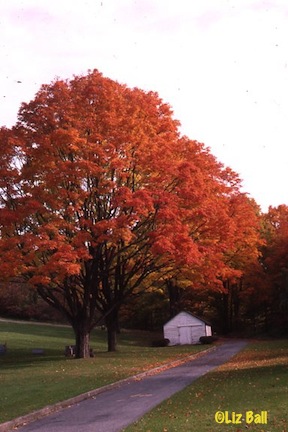Sugar Maple (Acer saccharum)
Appropriately named, the Sugar Maple is the primary source of the sweet sap used to make maple syrup and maple sugar. It is also called Hard Maple, Rock Maple, Curly Maple, and Bird’s-eye Maple, names related to the furniture and woodworking industry where this tree is also a major player. When planted in the right conditions, The Sugar Maple happens to be one of the best shade trees available for residential yards and gardens. All in all, it’s a great tree.
The Sugar Maple made its mark in the northeast in the 1600’s when the first settlers learned to make maple syrup from the local Native Americans. Some of those trees may still be with us since some Sugar Maples have survived for more than 400 years.
Although various types of maples grow through out the United States, some, like the Sugar Maple, are better suited to certain areas than others. Sugar Maples are a dominant tree in the deciduous forests of the Northeast and are found out to the Mississippi River in the northern Midwest.
Sugar Maples commonly grow from 75 to 100 feet or more with a trunk diameter of 2 to 3-feet. Open grown trees have shorter trunks with a rounded crown of many branches. A slow grower, the Sugar Maple may grow 60 feet in one hundred year period. They have a dense, upright oval to round crown with a broad spread, as least as wide as they are tall
 Individual Sugar Maple leaves are palm shaped with 5-deeply indented lobes, or points, reminiscent of a hand with fat fingers. They are relatively large in size, measuring from 3-1/2 to 5 inches wide. The margins between lobes are shallow and smooth, which distinguishes them from leaves of the similar-looking Red Maple , which has serrated lobe margins. Another difference in the leaves are the “U-shaped” connections between lobes of Sugar Maple leaves versus the “V-shaped” connections of Red Maples. During the growing season, the leaves are dull, light green on top with paler underside. But in fall, the Sugar Maple takes center stage when the leaves turn vibrant colors ranging from clear yellow to golden orange to orangish red, providing a fantastic show in many areas until the middle of October. New York, Pennsylvania, Michigan and parts of New England have taken advantage of this magnificent display by promoting fall color tours as tourist attractions.
Individual Sugar Maple leaves are palm shaped with 5-deeply indented lobes, or points, reminiscent of a hand with fat fingers. They are relatively large in size, measuring from 3-1/2 to 5 inches wide. The margins between lobes are shallow and smooth, which distinguishes them from leaves of the similar-looking Red Maple , which has serrated lobe margins. Another difference in the leaves are the “U-shaped” connections between lobes of Sugar Maple leaves versus the “V-shaped” connections of Red Maples. During the growing season, the leaves are dull, light green on top with paler underside. But in fall, the Sugar Maple takes center stage when the leaves turn vibrant colors ranging from clear yellow to golden orange to orangish red, providing a fantastic show in many areas until the middle of October. New York, Pennsylvania, Michigan and parts of New England have taken advantage of this magnificent display by promoting fall color tours as tourist attractions.
A pale yellow-green, Sugar Maple flowers are small, 1/5th to 1/2 inch long, with five tiny petals. They appear in clusters or loose sprays before the leaves emerge in April or May and are generally not considered noteworthy.
 Some trees produce spectacularly grained wood in curly, fiddleback, quilt, and bird’s-eye designs that is treasured by makers of fine furniture. This phenomenon is caused by a fungus which feeds on the cells under the bark, causing numerous depressions in the wood and thus creating this visual bird’-eye-effect so much in demand for use in veneers.
Some trees produce spectacularly grained wood in curly, fiddleback, quilt, and bird’s-eye designs that is treasured by makers of fine furniture. This phenomenon is caused by a fungus which feeds on the cells under the bark, causing numerous depressions in the wood and thus creating this visual bird’-eye-effect so much in demand for use in veneers.
Generally avoid placing Sugar Maple too near streets and roadways because they are very sensitive to road salt, used in winter to control ice. Sugar maples are also susceptible to soil related stress resulting from compaction caused from roadway and sewer construction. Since the roots of a healthy mature Sugar Maple can exceed twice the diameter of the crown the trunk of the tree they should be located at least 50 feet away from the street, but 100 feet is better. Also, Sugar Maples will not tolerate wet feet or extreme drought so good drainage and access to irrigation is important when choosing this tree.
Sugar Maple Choices
Newton Sentry has a single main leader stem. Bonfire is a rapid grower with nice red fall foliage. Green Mountain is good in dry, confined areas, has leathery, dark green leaves.

